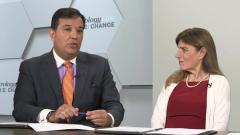
Other Anti-Amyloid Antibody Agents for Treatment of Alzheimer’s Disease
Drs McDade and Atri discuss differences and similarities between other ongoing anti-amyloid antibody trials in Alzheimer’s disease.
Episodes in this series

Marwan Sabbagh, MD: Changing gears a bit, Dr McDade. We’re a bit disappointing on the gantenerumab story, but donanemab is showing some exciting data. Could you discuss some of it that was brought up?
Eric McDade, DO: Yes. It’s important that these are the same class of therapy.
Marwan Sabbagh, MD: But they’re somewhat different.
Eric McDade, DO: Yes, exactly. Donanemab, lecanemab [Leqembi], aducanumab [Aduhelm], and then gantenerumab were the ones either recently reported or ongoing with some new data, or had been reported and we have different approval pathways for these as well. Broadly speaking, although there are some differences, some specific differences with the type of aggregated amyloid that they target. Again, they all target plaques, so you see plaque lowering with them. There are some differences in the frequency of how these are administered. And the other important thing is that although the populations were all relatively similar that are ongoing with gantenerumab, or have just completed with donanemab, aducanumab, lecanemab, gantenerumab that there were clear differences in things like safety, and particularly as it relates to ARIA [amyloid-related imaging abnormalities]. And so, in the aducanumab trial, a little over 20% of the population experienced an ARIA event and for APOE4 [apolipoprotein E] carriers, it was much higher. With the lecanemab data, for instance, it was almost half of that for the overall population. That will have impacts about how we use these drugs.
Marwan Sabbagh, MD: Absolutely.
Eric McDade, DO: And there’s also differences in how quickly they get to lowering amyloid as well. So donanemab, for instance, has demonstrated one of the most rapid decreases in amyloid levels relative to aducanumab and lecanemab, and then gantenerumab based on differences on things also, which will be relevant to how we use these. A titration schedule. In some of these, there’s not titration, whereas in others you have to build up. All of these will come into play when we think about the effects of these 2 because it does seem in all the trials, the quicker you get people down on their amyloid levels and the lower you get them down on their amyloid levels regardless of the specific details of the target, that probably is what helps particularly when you’re dealing with a symptomatic population, and time is of the essence. The longer you let that brain degenerate, the less likely you are going to be able to slow that down. That’s some of the important considerations when we think about the differences with these different therapies and why some trials may be a success and why others may not be a success. There’s actual differences in the way the trials have been conducted that contributes. And there may be differences in the mechanism of the drug between them that’s contributing as well. And that data still is going to be coming. And we’re excited for the full results for the phase 3 study of donanemab, which will be coming up later on this year.
Marwan Sabbagh, MD: Did you want to add anything to that?
Alireza Atri, MD, PhD: No. You put it correctly. Every study is a particular drug. They have a bit different mechanism of action.
Marwan Sabbagh, MD: The class is the same, but they’re different.
Alireza Atri, MD, PhD: Yeah. Inclusion, exclusion is different. The dosages are different.
Marwan Sabbagh, MD: The titration.
Alireza Atri, MD, PhD: The titration’s different. Some are every other week, 1 month, sub-q [subcutaneous], IV. But we’re getting a picture, again, of what you were saying. Is that you lower it enough, there seem to be four groups to see clinical benefit. And if you have over 18 months—again, these weren’t 5-year trials. They were, for the randomized control part, 18 months. If you’re getting about, let’s say 25% to 35%, that’s the equivalent of 5 to 7 months of benefit, relative to placebo in those 18 months.
TRANSCRIPT EDITED FOR CLARITY
Newsletter
Keep your finger on the pulse of neurology—subscribe to NeurologyLive for expert interviews, new data, and breakthrough treatment updates.












































